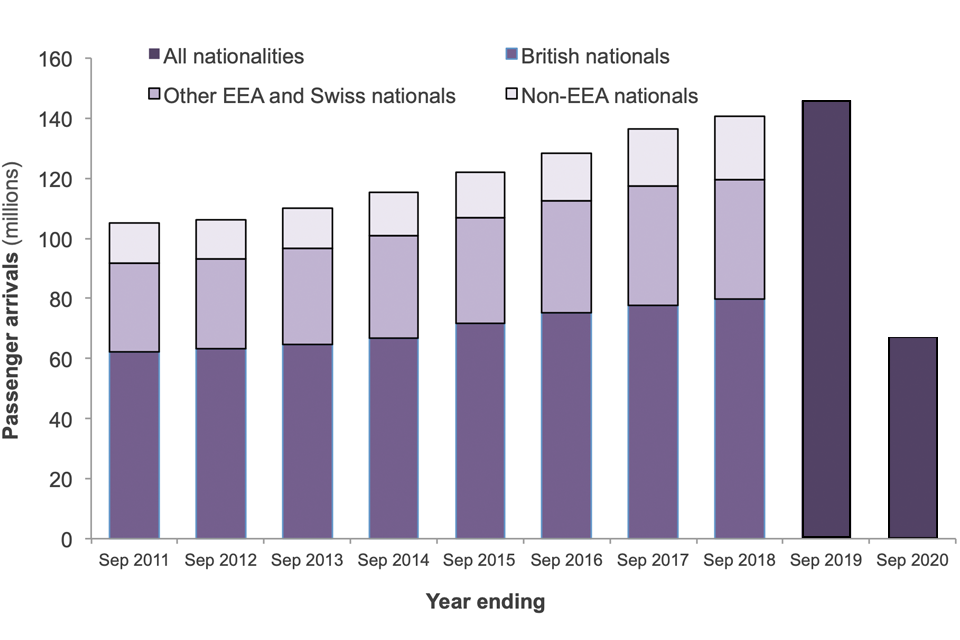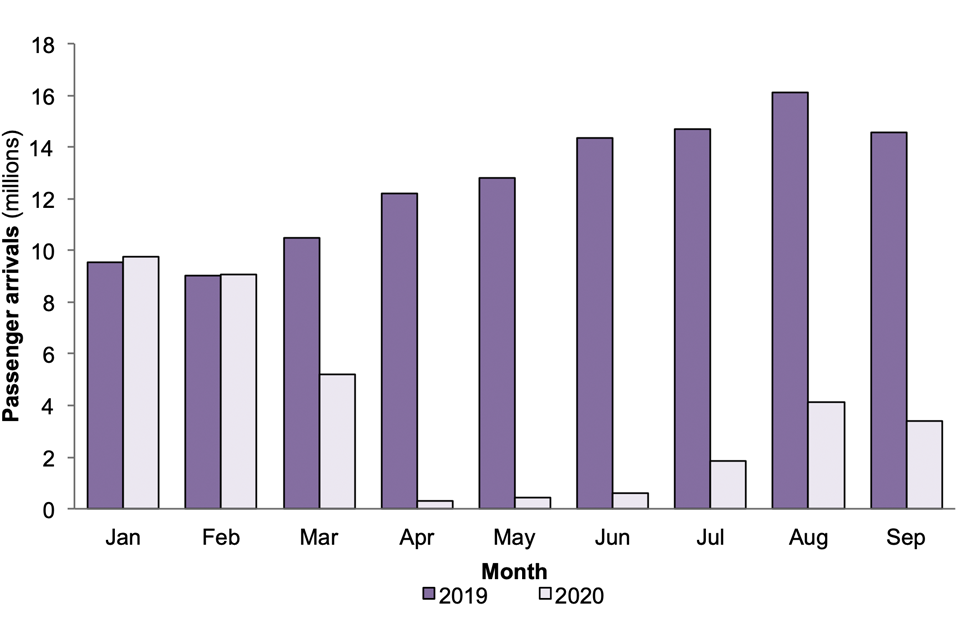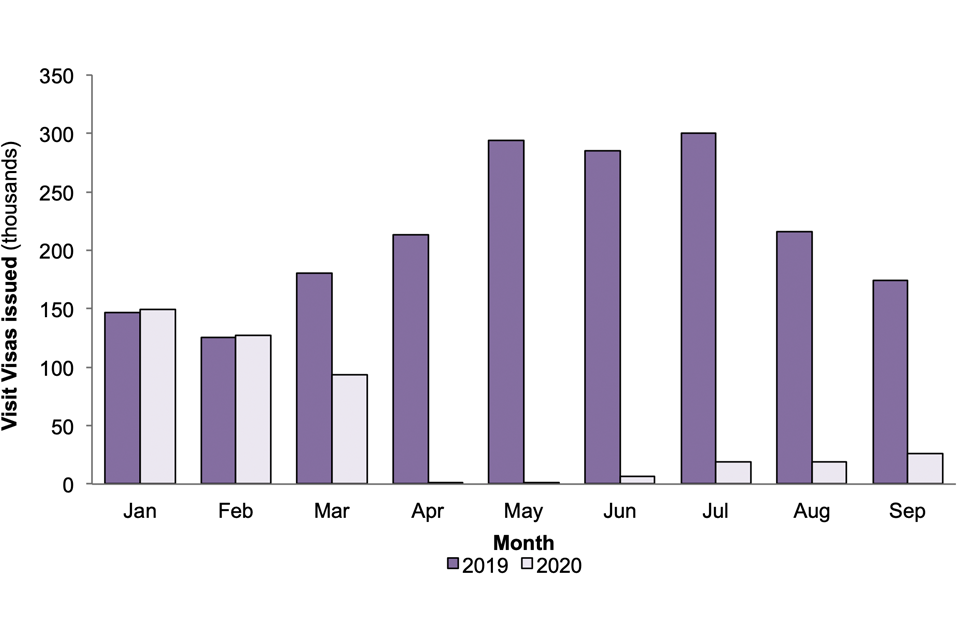How many people come to the UK each year (including visitors)?
Updated 27 November 2020
Back to ‘Immigration statistics, year ending September 2020’ content page.
This is not the latest release. View latest release.
Data relate to the year ending September 2020 and all comparisons are with the year ending September 2019, unless indicated otherwise.
On 11 March 2020, the World Health Organisation (WHO) declared the COVID-19 outbreak a global pandemic. A range of restrictions relating to the outbreak began on 12 March 2020, the Foreign and Commonwealth Office (FCO) advised against all non-essential overseas travel on 17 March 2020, and advised all British travellers to return to the UK on 23 March 2020, the same day as the first UK lockdown measures were announced.
Restrictions were put in place across Europe and other parts of the world in the run up to the UK outbreak, which will also have impacted travel to the UK prior to these dates. The COVID-19 pandemic has had a significant impact on the UK immigration system, both in terms of restricting migrant movements to and from the UK and also operational capacity.
Year ending comparisons that follow will include impacts resulting from the restrictions put in place during this period of the pandemic.
This section contains data on:
- Passenger arrivals to the UK
- Grants of Entry clearance visas to individuals outside the UK
- Visitors to the UK
1. Passenger arrivals to the UK
There were an estimated 67.2 million passenger arrivals in the year ending September 2020 (including returning UK residents), a 54% (78.8 million) decrease compared with the previous year. This was driven by significantly fewer passenger journeys in the second and third quarters of 2020, when there was an 87% (74.0m) decrease compared to the same period in the previous year, due to the travel restrictions imposed as a result of the COVID-19 pandemic. Further detail on passenger arrivals during this period is provided in the separate Home Office publication ‘Statistics relating to passenger arrivals since the COVID-19 outbreak, November 2020’.
Figure 1: Passenger arrivals to the UK, by nationality group, years ending September 2011 to September 2020

The chart shows the number of passenger arrivals to the UK, by nationality group over the last 10 years.
Source: Passenger arrivals (admissions) summary table – Adm_01_q
Notes:
- Nationality breakdowns for 2019 are not currently available, as the data were derived from landing cards (see ‘Landing cards’).
In 2018, the latest period for which a breakdown is available, there were 142.9 million passenger arrivals, of which 81.7 million (57%) were returning British citizens, 40.8 million (29%) other EEA nationals and 20.4 million (14%) from outside the EEA. Only certain nationalities (‘visa-nationals’) are required to obtain an Entry clearance visa before coming to the UK, which is why there are considerably more passenger arrivals than visas granted.
There were 1.4 million visas granted in the year ending September 2020, a 56% decrease compared with the previous year, so a similar reduction as seen for overall arrivals. Of the visas granted, two thirds (67%) were to visit, 13% were to study (excluding short-term study), 10% were to work, 3% were for family, and 8% for other reasons.
Figure 2: Entry clearance visas granted, years ending September 2011 to September 2020

The chart shows the number of Entry clearance visas granted over the last 10 years.
Source: Entry clearance visa applications and outcomes – Vis_D02
1.1 The impact of COVID-19
In the third quarter of 2020 (July to September), there were an estimated 9.3 million passenger arrivals (including returning UK residents). This is 79% (36.0 million) fewer than the same period in 2019. Prior to this, in the second quarter of 2020 (April to June), there was an estimated 1.3 million passenger arrivals (including returning UK residents), 97% (38.0 million) fewer than the same period in 2019.
Figure 3: Passenger arrivals to the UK, by month, January to September 2019 and 2020

Passenger arrivals, comparing 2020 and 2019. In Jan and Feb 2020, numbers were like 2019. In March, they dropped by around half. April to June, arrivals were at low levels before rising slightly over the next three months.
Source: Passenger arrivals (admissions) summary table – Adm_01_q
Data published on the total number of passenger arrivals to the UK in this section do not include detailed breakdowns (such as nationality, or route) for arriving passengers. In addition to data published here, the Home Office has published Statistics relating to passenger arrivals since the COVID-19 outbreak which includes data up to October 2020 showing the impact of the COVID-19 outbreak. These data are not directly comparable with the passenger arrivals data as they come from different sources. However, given the clear public interest in passenger arrivals since the COVID-19 pandemic, this data has been made available as a supplement to the data published in the Quarterly Immigration Statistics.
The separate release contains more detailed information (including daily figures) relating to passengers arriving into the UK between January and October 2020. These data show that there were around 1.7 million passenger arrivals to the UK by air routes in the month of October 2020 (from API data). This was higher than the average for April to June 2020, following the start of the first UK lockdown, when there were less than 200,000 air arrivals per month. However, the number remains substantially lower than levels seen prior to the COVID-19 outbreak in the UK and is around 82% lower than the figure for October 2019, when there were 9.8 million arrivals.
Due to the COVID-19 pandemic, visa application centres were closed by 31 March 2020 and began gradually reopening from June 2020. In the third quarter of 2020, the number of visitor visa applications was 89% lower than the same period in 2019. In the same period the number of visitor visas granted was down 91%.
Visitor visa applications and grants were close to zero during April and May 2020. The operations began to recover in June, with 3,680 visitor visa applications and 6,236 grants. The numbers of grants continued to grow from July to September but remain far lower than 2019. The recovery in visit visas has been far smaller than the recovery seen in other visa categories.
Figure 4: Visitor visas issued, by month, January to September 2019 and 2020

Visit visa grants, comparing 2020 and 2019. In Jan and Feb 2020, grants were like 2019. In March, they dropped by around half. April to June, there were few grants. Numbers began to recover July to Sept but still lower than 2019.
Source: Entry clearance visa applications and outcomes: Vis_D02
2. Visitors to the UK
Many nationalities, including US nationals (who account for one-third of passenger arrivals) do not normally require a visa to visit the UK; consequently, there are considerably fewer Visitor visas granted than visitor arrivals. In the year ending September 2020, there were just over one million applications for Visitor visas, a decrease of 61% compared to the previous year, largely as a result of the COVID-19 pandemic.
Over the same period, there were 917,683 Visitor visas granted, a 61% decrease, opposing the general upward trend over the last 10 years. Chinese (171,610) and Indian (156,725) nationals together accounted for 36% of all Visitor visas granted.
Additional information on visitors to the UK are published by the Office for National Statistics (ONS) in its quarterly ‘Overseas travel and tourism statistics’.
3. About these statistics
The statistics in this section provide an indication of the number of people who enter the UK.
The data do not show whether, or when, an individual arrived in the UK, what they did on arrival to the UK or how long they stayed in the UK.
Many non-EEA nationals do not normally require a visa to visit the UK. As a result, they will be counted in the passenger arrivals data but not in the visa data. A list of designated nationalities referred to as ‘visa nationals’ who do require a visa in order to visit the UK can be found in ‘Immigration Rules Appendix V: visitor rules’.
EEA and Swiss nationals do not require a visa to come to the UK for any reason.
For several reasons, data on passenger arrivals are not directly comparable with data on Entry clearance visas granted. A summary of what each dataset counts is provided below.
3.1 Passenger arrivals
Data on passenger arrivals relate to the number of arrivals into the UK. The data include British, EEA and Swiss nationals, as well as non-EEA nationals. For non-EEA nationals who are subject to immigration controls, more detailed information is available on their nationality and purpose of their journey up until 2018.
Passenger arrivals are counted each time an individual enters the UK. Where an individual enters the UK more than once in a period, they will be counted each time they enter (but if they arrive each time on the same visa, they will be counted once in the visas data).
Visitor arrivals data included in this topic are based on landing cards completed as people cross the border. In light of the introduction of new digital systems at the border, the use of landing cards was reviewed (see ‘Landing cards’). The review resulted in the decision to remove the need for non-EEA nationals to complete a landing card on arrival into the UK. Further data relating to visitor arrivals will not be available until an alternative method of collection is developed.
3.2 Entry clearance visas
Data on Entry clearance visas in this section refer to the number of visas granted for all reasons within the period. If an individual was granted multiple visas in a given period, this will be counted as multiple grants in the statistics. If an individual entered the UK multiple times within the period for which a visa was valid, this will be counted as one grant in the visa statistics, but multiple arrivals in the passenger arrivals data.
Year-on-year comparisons of the number of decisions can be affected by quarterly fluctuations in the data. Such fluctuations can be examined in more detail in the quarterly data that are available in the published tables.
Several known factors may have affected the number of applications and outcomes of visit-related visas over time. For example, the Home Office launched a two-year Chinese visa pilot in January 2016 for Chinese nationals. The increase in longer-term Visitor visas may affect the number of subsequent re-applications by Chinese nationals.
More information on non-visitor arrival and visa data by category is included in ʻWhy do people come to the UK? To work’, ʻWhy do people come to the UK? To study’ and ʻWhy do people come to the UK? For family reasons’.
3.3 Landing cards
On 5 August 2017, the Home Office launched a consultation on ending the requirement for non-EEA passengers to present a paper landing card on arrival into the UK from 1 October 2017. The consultation set out the statistical implications of the change and the consultation closed on 2 September 2017. The government confirmed in the Spring Statement 2019 that to coincide with the ePassport gates expansion, the government would begin to abolish landing cards for non-EEA travellers. On 20 May 2019, it removed the need for all non-EEA travellers to fill in landing cards upon arrival in the UK and expanded the use of ePassport gates to seven more countries. The government’s response to the consultation was published in May 2019. As anticipated in the original consultation, ahead of new electronic data sources being developed, the withdrawal of landing cards has resulted in a temporary loss to the passenger arrivals data broken down by nationality and reason for travel. The last set of published data on non-EEA nationals arriving in the UK (based on Landing Cards), cover the period 2004 to 2018) are available in ‘Immigration statistics, year ending June 2019 second edition’. Data on the total number of passenger arrivals will continue to be available as this comes from a different source.
4. Data tables
- Sponsorship summary tables
- Detailed sponsorship datasets
- Entry clearance visas summary tables
- Detailed Entry clearance visas datasets
- Admissions tables
We welcome your feedback
If you have any comments or suggestions for the development of this report, please provide feedback by emailing MigrationStatsEnquiries@homeoffice.gov.uk. Please include the words ‘PUBLICATION FEEDBACK’ in the subject of your email.
We’re always looking to improve the accessibility of our documents. If you find any problems or have any feedback relating to accessibility, please email us.
See section 7 of the ‘About this release’ section for more details.
